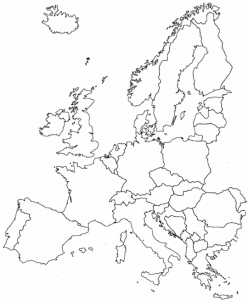61 Europe: Political Geography II – Europe’s Shift to the Right
Reducing something as complex as political ideology to labels is problematic. Still, if someone identifies as “liberal,” or “moderate,” or “conservative,” you can probably make a few guesses about his or her political ideals. Traditionally, academics speak of political ideology with the terms left (liberal), center (moderate), and right (conservative). We can add nuances to that political spectrum. Someone who is “far right” is very conservative, while someone who is “far left” is very liberal. And sometimes the prefix “ultra” is applied to extremists (the Nazis were “ultraright,” and the Bolsheviks was “ultraleft”). Someone who is center-left is a moderate who leans liberal; someone who is center-right is a moderate who leans conservative.
To give you a sense of the spectrum, consider the following American politicians: Bernie Sanders perhaps best exemplifies the political left. Hillary Clinton and Joe Biden are examples of the center-left. Barack Obama was on the left as a senator, but as president he governed more from the center-left. Jeb Bush and Mitt Romney are examples of the center-right, while Donald Trump and Ted Cruz are examples of the right.
For the second half of the 20th century, Europe was dominated by left and center-left governments (and, of course, the Soviet bloc in Eastern Europe was dominated by far-left governments). This move to the left was stimulated by a few factors. One was a reaction against the far-right fascists governments that had launched World War II, and who were responsible for the atrocities of the Holocaust. Another was a reaction against a social class system that had been relatively rigid for centuries. And the move to the left was further fueled by the anti-establishment, youth-driven countercultural movements that swept through much of the world in the 1960s.
Left and center-left governments were hardly uniform in nature but, in general, they promoted the following:
- Higher wages for the working class, and other labor rights.
- Increased environmental responsibility, such as pollution reduction, sustainable development, and shifts to renewable energy sources.
- Increased immigration to offset the consequences of an aging population.
- Better social safeguards for the general population, including generous public pensions, free or low-cost health care and education, and expansive social welfare benefits.
- Increased taxes on corporations and the wealthy to pay for these social programs.
- A commitment to solving political crises with diplomatic solutions, rather than military solutions.
- Stronger integration into the Common Market and, later, the European Union.
The left has not completely disappeared in Europe, of course, but beginning in the 1980s, and dramatically accelerating in the 2000s, the left and center-left began to face some serious challenges, including:
- A fear of mounting public debt, coupled with a perception that the right’s policy of cutting government spending would solve the debt issue.
- A fear that increased immigration was taking jobs away from native citizens, and that immigration was destroying the unique national cultures of individual countries.
- The automation and outsourcing of manufacturing and primary sector jobs. This eroded membership in labor unions, which were traditionally major supporters of the left.
- An aging population. As people get older, usually their political ideology grows more conservative. Europe has a lot of old people. It has comparatively few young people.
- A backlash against high taxes and strong government regulation of the economy. This is similar to “Reaganomics” in the United States and its political descendant, the Tea Party.
- A backlash against the increased power of the European Union.
As a result, many countries in Europe have seen the rise of right and center-right governments, which promote:
- Relaxed environmental, labor, and financial regulations.
- Strong restrictions on immigration.
- “Austerity” measures, such as lower taxes and lower government spending
- Stronger militaries
- Euro-skepticism: a desire to limit the power of the European Union or, in the case of Britain, a campaign to leave the EU entirely.
Perhaps the biggest factor in the rise of the right has been anti-immigrant sentiment. This is not dissimilar to the political groundswell that sent Donald Trump to the White House. President Trump had many different policies and proposals, of course, but certainly his pledge to “Build the Wall” was one of the most resonant. Anti-immigration voters overwhelmingly lean right, and some of Europe’s emerging far-right parties, such as France’s National Front, are almost entirely fixated on reducing immigration.
Did You Know?


